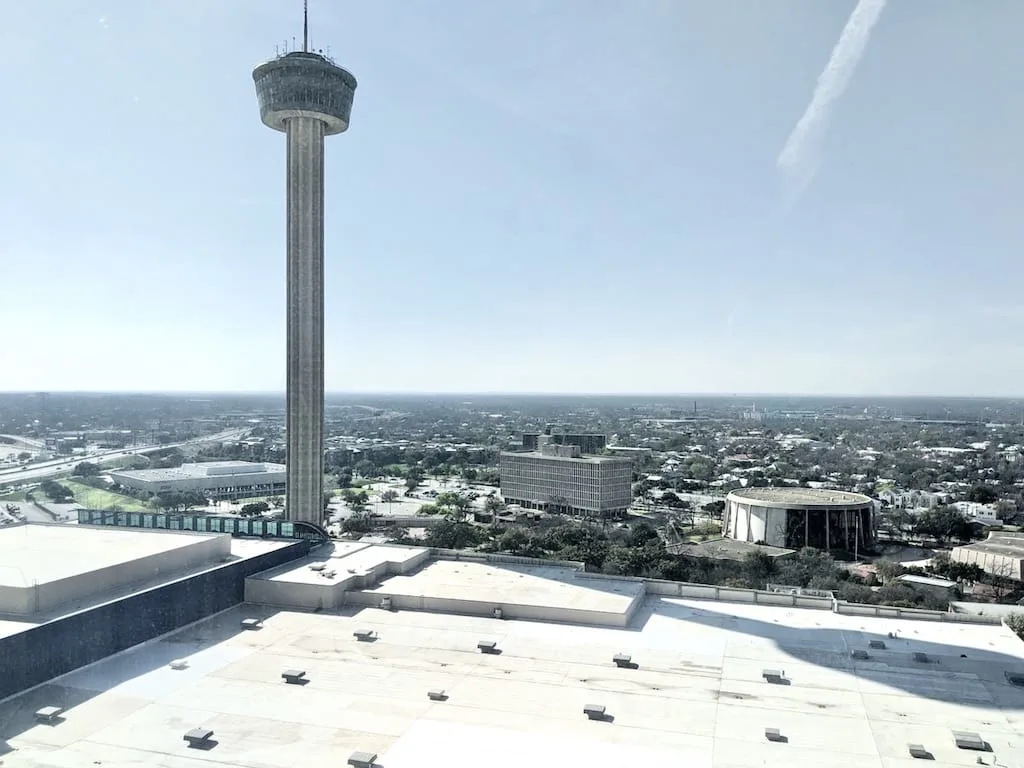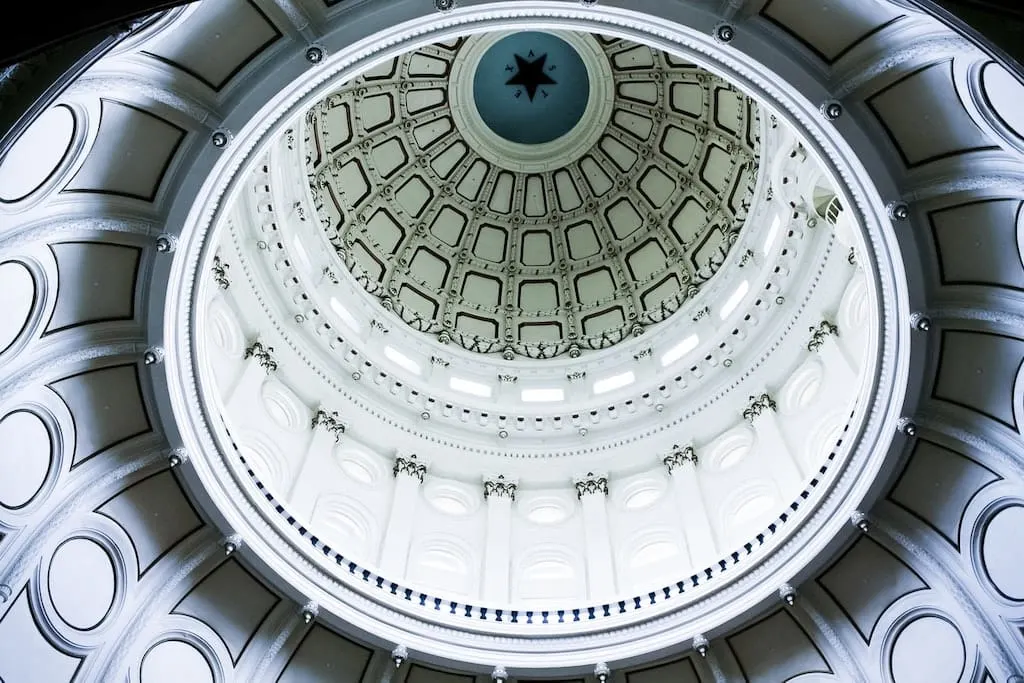Expert travel storyteller Jordan Adkins, founder of InspiredByMaps.com, brings a decade of adventures across 101 countries and 450+ UNESCO sites into rich, off-the-beaten-path narratives, melding ecological expertise with genuine, seasoned travel insights. His full bio can be found here.
Texas, the second-largest U.S. state by both area and populations, is one of the world’s most underrated travel destinations filled with Latin-American cultural influences, animated people, beautiful nature, and theme parks. So many theme parks!
When approaching a trip to the ‘Lone Star State’, you will want to tick off as many famous Texan Landmarks as you can – and the best way is to do that is often by renting a car. After all, with 268,597 mi² of land and desert along with a sprawling mix of cities, the limited bus and train options simply aren’t going to cut it.
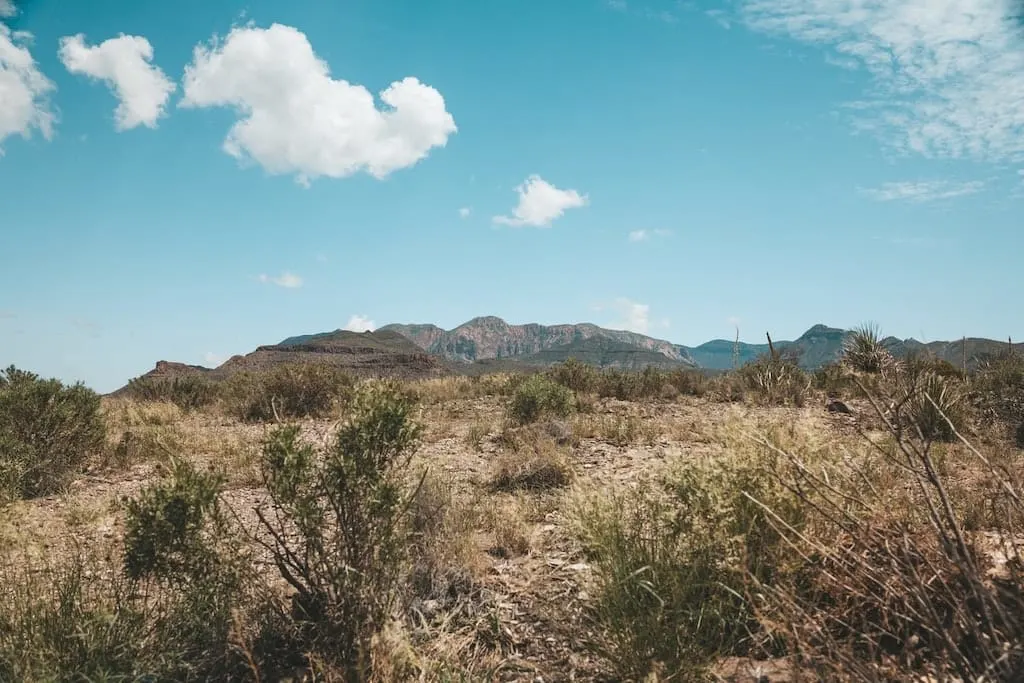
But first – what is a landmark?
A landmark is a recognizable natural or artificial feature that typically stands out from its environment and has become a local or national symbol. For modern tourists, a landmark is useful for navigation – in terms of both being a physical waypoint and in trying to help you organize your itinerary.
Getting the off-the-beaten-track is all well and good, but at the end of the day – there are some spots you just have to see when you visit a country. Think about the Disney World in Florida or the Acropolis of Athens. Instantly recognizable places you couldn’t miss if you tried. And Texas has more than its fair share, because, well – everything is bigger and better here!
There are so many places to explore in Texas; you could spend your life enjoying their richness and scrape only the surface. That is why we created this cheat sheet to guide you on your journey.
How many of these famous Texan Landmarks can you cram into one trip? If you plan it right, you might just hit them all — plus discover plenty more of your own favorite spots while you’re at it!
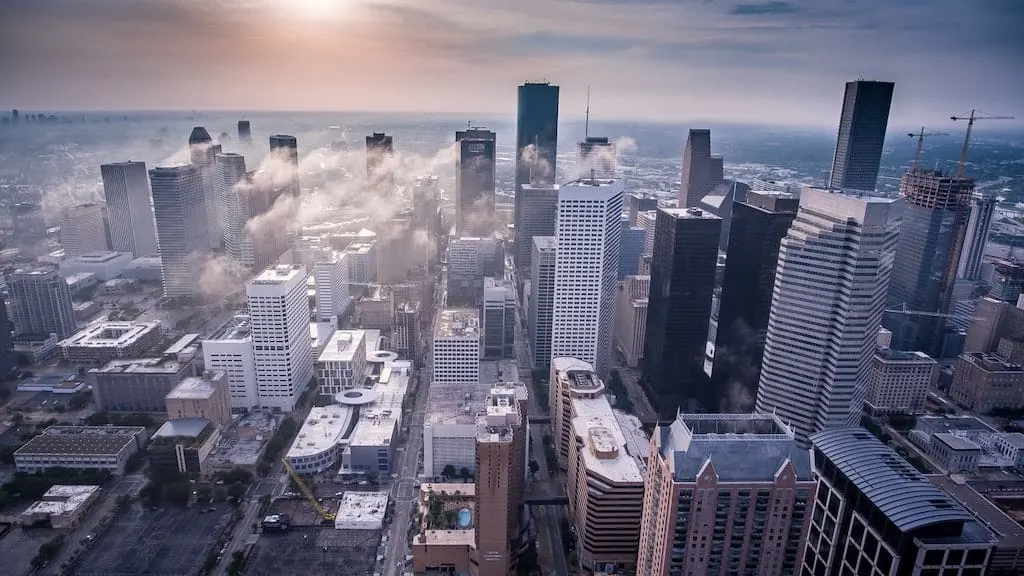
30 Famous Texas Landmarks To Plan Your Road Trip Around! 🚗
Page Contents
- 30 Famous Texas Landmarks To Plan Your Road Trip Around! 🚗
- Apollo Mission Control Center
- Aransas National Wildlife Refuge
- Congress Avenue Bridge
- Enchanted Rock
- Mission San Juan Capistrano
- Natural Bridge Caverns
- Pegasus Plaza
- Prada Marfa
- San Antonio River Walk
- Selena Museum
- Six Flags Over Texas
- Texas Capitol Building
- The Alamo
- The Sixth Floor Museum at Dealey Plaza
- Tower of the Americas
Apollo Mission Control Center
An unassuming room is located in Building 30 of NASA Johnson Space Center in Houston. NASA monitored nine Gemini missions and all Apollo lunar missions from this Mission Control Center.
History was made here by the Apollo 11 mission on July 20, 1969, with Neil Armstrong’s words, “Houston, Tranquility Base here. The Eagle has landed.” This room is still filled with all the tense, energetic, anxious, and triumphant emotions of the NASA team working inside this room that day, and of all the people around the world. From launch at the Kennedy Space Center to splashdown in the Pacific Ocean, the entire Apollo 11 mission was controlled from here.
NASA continued to monitor all subsequent Apollo missions and 21 space shuttle missions from this Mission Control Center. It was added to the U.S. National Register of Historic Places in 1985. After two years of painstaking restoration, it was reopened on the 50th anniversary of the Lunar landing. Restoration is done to preserve every last detail of the exact moment of the Moon landing. NASA upgraded the consoles during the shuttle missions, and all were configured back to the Apollo era. Even the small details such as ash-trays, binders, pencils, headsets, and coffee cups were added to complete the picture.
A ticket is required to visit Johnson Space Center, which includes several exhibits. Children below three years are admitted free. A day ticket is about $30. A free timed NASA Tram Tour ticket is required to visit the Apollo Mission Control Center that is available on the day. Timed tickets are available on a first-come, first-served basis. Try to arrive early and keep enough time to explore all the incredible exhibits. Also, you may buy tickets online to avoid lines at the ticket window.
I will highly recommend a visit to Rocket Park to see the most powerful rocket ever flown – Saturn V. The mighty Saturn V rocket is 363 feet tall and is displayed lying down. Built in the 1950s, with 1.5 million pounds of thrust, the Saturn V remains the tallest, heaviest, and most powerful rocket ever launched successfully.
Among so many cool things to explore at Space Center, for me touching the moon rock was the most emotional moment after Mission Control Center. Stop by Starship Gallery to admire these billions of years old rocks and touch the moon.
And then Charlie Duke from Mission Control Center replied to Armstrong and Buzz Aldrin, “Roger, Tranquility. We copy you on the ground. You’ve got a bunch of guys about to turn blue. We’re breathing again. Thanks a lot.”
Explored by Binny Marwaha from aspeckintime

Aransas National Wildlife Refuge
Along the Texas coastline is one of the state’s most incredible natural landmarks, the Aransas National Wildlife Refuge, home to many unusual wildlife species. It is one of the protected areas for migratory waterfowl and breeding ground for many other migratory birds and other wildlife, including whooping cranes, sea turtles, reddish egrets, and alligators.
Aransas N.W.R. is situated on the southwest side of the San Antonio Bay, formed by the mouth of the Guadalupe River. It is 151 miles southeast of San Antonio and 173 miles southwest of Houston. It’s the perfect place to take a break from the hustle of the city and admire the wildlife. The area of Aransas N.W.R. is a 115,324 acre (466.7 km2).
Apart from the endangered whooping crane, birdlife in Aransas N.W.R. includes ducks, herons, egrets, ibises, ospreys, hummingbirds. It is home to almost 400 species of birds, which you can observe on the available trails.
Furthermore, it is possible to admire American alligators, collared peccaries, snakes, and bobcats, which inhabit the refuge’s grasslands, freshwater ponds, and marshes. So, this place is a real paradise for nature lovers and wildlife photography enthusiasts. The best idea for visiting is taking a 16 miles long Auto Tour Loop. The paved loop provides a ride through “Texas savannah.” It’s possible to see along the way deer, hawks, javelina, bobcat, and an occasional rattlesnake.
Several short (0.1 – 1.7 mile) hiking trails bring you closer to nature, allowing observing and photographing wildlife from viewpoints. There are wooden footbridges above the water, which facilitate bird watching. There is also a built-in 2012 Observation Tower. The 40′ tower gives the best chance to see a whooping crane. It is built in a wooded area but rises above the trees for a panoramic view of San Antonio Bay and Mustang Lake.
Some top tips would be that the refuge trails and the auto tour loop are open seven days a week from 30 minutes before sunrise until 30 minutes after sunset.
The entrance fee is $5 for two or more adults in a vehicle. But the entrance is free with an Annual entrance pass to National Parks, National Wildlife Refuges, National Forests. The best time to see wild animals and birds is dawn and early morning when they are most active. The best time of year to see Whooping Cranes is from December to February. But they typically begin arriving by mid-October and leave mid-April.
Explored by Agnes from The Van Escape
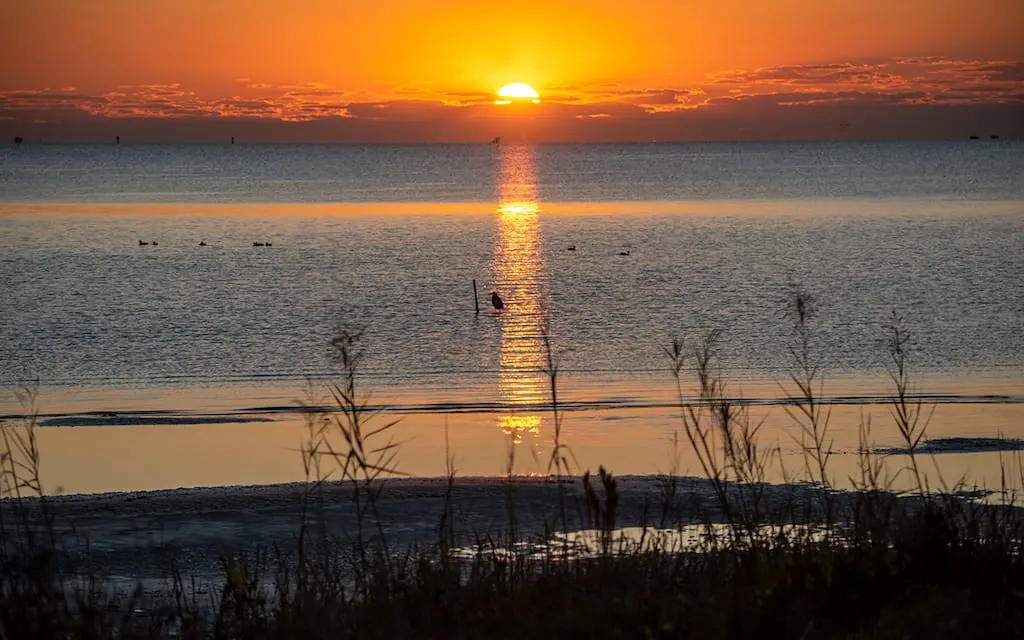
Congress Avenue Bridge
You might wonder why a bridge—a hunk of concrete with cars zooming over it—is such a famous landmark in Texas. But the Congress Avenue Bridge in Austin, TX, is special. Here’s why it should be on your Texas itinerary.
The Congress Avenue Bridge is more than just a way for people to get from A to B. It’s also home to the largest urban bat colony in the world.
Austinites and visitors alike flock to the bridge just before dusk. In the twilight, the bridge’s 1.5 million Mexican free-tailed bats fly out from the east side of the bridge. These critters sleep all day and come out to feed when bugs are most active, which is one reason why warm Austin has so few mosquitoes!
The bats haven’t always been celebrity residents in Austin. They began moving in after a 1980 renovation of the bridge, which made bat roost-sized crannies perfect for female bats to raise their pups. At first, Austinites freaked out about the newcomers. A public education campaign prevented an extermination and changed the city’s mind. Now the bats make Congress Avenue Bridge one of the most famous landmarks in Texas.
The Congress Avenue Bridge is hard to miss, as Congress Avenue is one of the main roads in the city. And if you get turned around, ask someone where to see the bats. Just about everyone you meet will be able to point you in the right direction.
To see the bats in action, head to the bridge, which connects South Austin and Downtown, before dusk (exact timing varies depending on the time of year). Stake out a spot on the east side of the bridge. You’ll get the best view in the first row. At dusk, you’ll see the bats emerge from beneath you.
Alternatively, you can rent a kayak and paddle Lady Bird Lake (which the bridge crosses) to see the bats from below. Kayak companies run tours, and you can also join a boat tour that will take you right under the bridge at precisely the right time to get the best view.
Explored by Catherine Ryan Gregory from To & Fro Fam
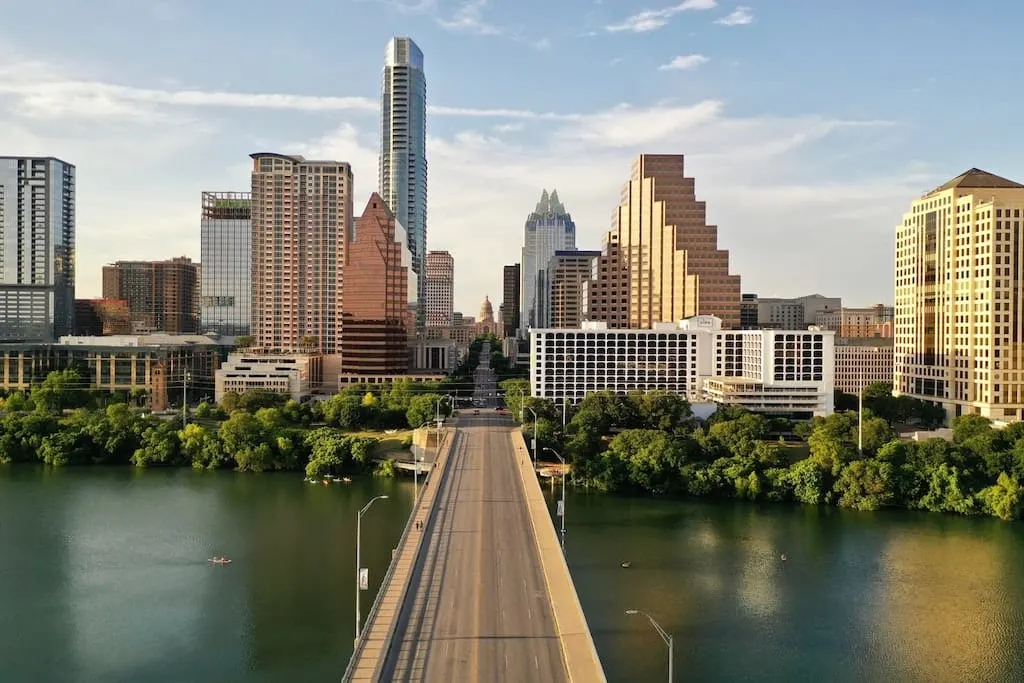
Enchanted Rock
Enchanted Rock is an iconic Texas landmark in the Texas Hill Country. Just outside of the tiny German town of Fredericksburg, this large granite dome rises up out of the hill country. Fredericksburg is an hour and a half from Austin and is one of the best day trips from Austin. Since everything is bigger in Texas, you do need a car to get there.
The hike up the big granite dome is something nearly every Texas has done. It’s an easy hike uphill. You don’t need to be athletically fit to hike here. Enchanted Rock is a fantastic family destination for all ages and is suitable for all skill levels. If you’re in a hurry, you can easily visit it in an hour, but the park is so beautiful to try to dedicate more time to truly enjoy it. Pack a picnic to enjoy at the picnic tables in the park after your hike.
Enchanted Rock is part of the Enchanted Rock State Natural Area, which includes other hiking trails as well as campsites. If you love the outdoors, spend an entire weekend camping under the stars and exploring the trails in this stunning piece of the hill country.
If you’d prefer more civilization (and perhaps a soft bed), nearby Fredericksburg is a beautiful town. It is home to Texas’ wine region (all open for visitors). There are German Biergartens and boutique shopping downtown. Rent a home in Fredericksburg, and you’ll be a short drive from Enchanted Rock. This is the ideal weekend trip for couples, groups of friends, and families alike.
Explored by Erin from Sol Salute
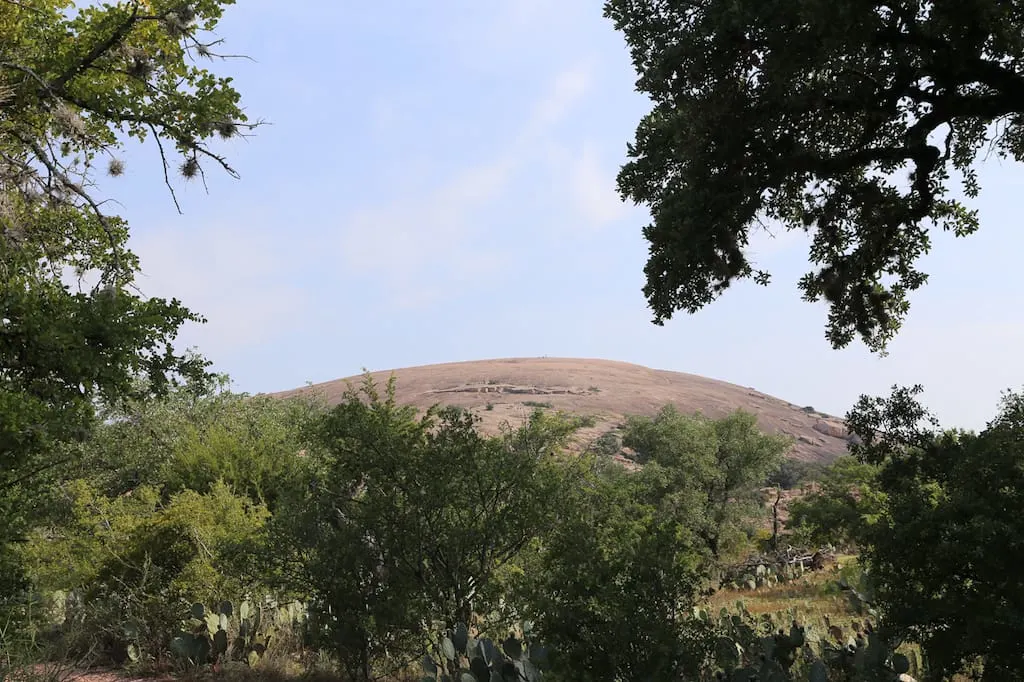
Mission San Juan Capistrano
Mission San Juan Capistrano was established in 1731 by Spanish Catholics of the Franciscan Order, on the eastern banks of the San Antonio River in present-day San Antonio.
The San Juan society had been self-supporting with Indian craftsmen created iron tools, clothes, and hides within the complex and melons, gourds, grapes, and peppers being grown in extensive gardens and orchards – some of which have been recreated today. Outside of the mission complex, indigenous farmers created irrigated areas and grew crops like maize (corn), sweet potatoes, and sugar cane.
This production helped to not only support and sustain the San Antonio missions but also the local communities and military garrisons in the region. By the mid-1700s, San Juan was a regional supplier of agricultural goods. Its rich farms and pasturelands allowed it to develop a vast trade network east-to-Louisiana and south-to-Mexico. This stable economy meant the Mission survived years of epidemics and Indian attacks.
However, it was secularized in 1794, after which point many of the native population of the Mission were either disbanded, moved to other missions, or Hispanicized. Construction had begun on a grander church, but it was abandoned halfway through completion in the face of this population decline. The ruins of this church can still be a witness on the site. Largely neglected since 1840, the Mission (along with a series of others on the San Antonio River) was protected in 1934 as local heritage. The church, priests’ quarters, and other structures were reconstructed during the 1960s.
Today protected as UNESCO World Heritage of the U.S.A., the Mission San Juan Capistrano is undoubtedly a landmark of Texas and offers incredible insight into the colonization of the southern U.S.A. It is free to visit, and you should allow at least a few hours to explore the exhibits, take a tour, and wander the grounds.

Natural Bridge Caverns
The Natural Bridge Caverns are the largest caves in Texas operating in a commercial capacity – and a designated national landmark of the U.S.A. The name comes from the 60 ft natural calcareous slab bridge, which extends over a grand amphitheater at the entrance to the Cavern, created when a sinkhole collapsed below.
The caverns are situated next to the city of San Antonio and have a range of unusual geological structures and speleothems that not only make them exceptionally beautiful, but of unique interest to scientists. Interestingly, the Natural Bridge Cavern is also a consistent 21 degrees Celsius (70 ° F) during the year, making it a nice reprieve in the middle of summer – though the humidity rate is always 99%. The lowest portion of the Cavern, accessible on a public tour, is 180 feet below ground of the Cavern; however, undeveloped sections are known to be 230 feet deep.
The caves continue to evolve slowly, as mother nature’s work is never done. Because of the porosity of calcite, rainwater passes down the various layers of rock, dissolving calcite as it goes. This fragile mineral then forms all the stalactites and stalagmites in the caves of the Natural Bridge. This only adds to the space’s natural appeal. Water reached the caves after exiting the calcareous stone and continuously dripping in the cave, thereby maintaining a waxy luster, which can be seen in most caverns and contribute to the humidity.
Discovered in 1961 and opened to the public in 1964, the site continues to be developed for commercial purposes. There is a variety of tours on offer, with different trails based on interests. Tours depart every 30 minutes and start from $21.
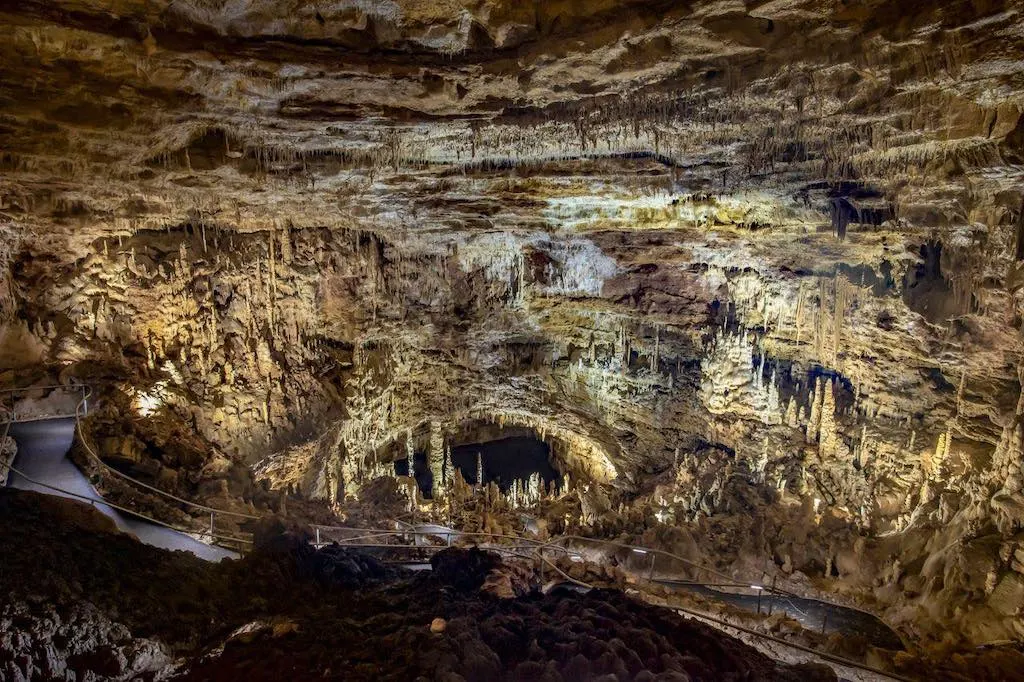
Pegasus Plaza
Dallas has many icons, but one of them seems to get more questions than the rest. The Pegasus, a mythical Greek creature that looks like a horse with wings, appears all over Dallas. Its wings appear as part of the logo for a local sports team, there is a downtown plaza named after the Pegasus, and there are murals depicting it. But it’s the neon red Pegasus that is the true Dallas icon. In 1934 the original 11-foot neon red Pegasus first flew into Dallas atop the Magnolia Hotel. For over 60 years, the bright red Pegasus light up the Dallas night sky.
Of course, over time, the Pegasus suffered weathering damage, and eventually was taken down. But the story of the Pegasus didn’t end. The neon sign was restored and now sits outside the Omni Hotel on a 22-foot tall oil derrick. This Pegasus isn’t merely a stationary sign; the neon red Pegasus rotates, allowing it to be seen from all directions. At its current location, guests can get close enough to pose in front of the iconic mascot, and they get a bonus Dallas icon in their photo as well, Reunion Tower. If you want to see the Pegasus in her glowing red, you’ll need to visit after the sun goes down.
You can also walk over to the Magnolia Hotel and see the new Pegasus flying atop, or step into the lobby and see the beautiful Pegasus statue that resides there. You can also walk just down the street from the original Pegasus statue to see the cattle trail sculpture, which makes another iconic Dallas photo opportunity.
Explored by Julie from Julie Measures
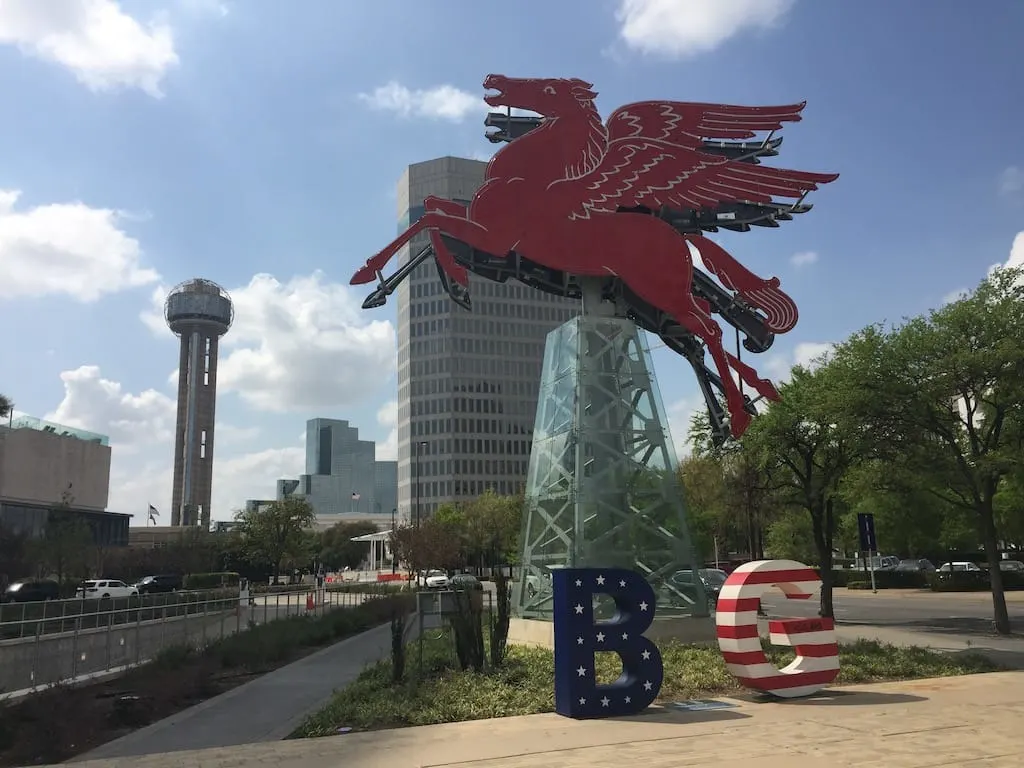
Prada Marfa
One of the most unique and quirky landmarks in Texas is found in what many would consider “the middle of nowhere”. About 30 minutes outside of the artistic community of Marfa, and only a couple miles outside the tiny town of Valentine, you’ll find a fully stocked Prada store.
The storefront in the middle of the unforgiving desert in West Texas isn’t actually an operating store, but an art installation created by an artistic team from Berlin, Germany. Constructed of an adobe-like building material, the art installation, which was created in 2005, was originally intended to be biodegradable and eventually dissolve back into the earth.
That plan changed, and the building was reinforced, and security cameras were added after vandals broke into the store, stole its contents, and graffitied the building the night the installation was completed.
To view this unique art installation requires taking a West Texas road trip because the Prada storefront is hours away from the nearest airport, but that doesn’t stop thousands of people from flocking to the roadside attraction for a photo op. Due to its peculiar appeal, the small Prada store has become increasingly popular amongst celebrities and Instagram influencers, who happily drive hours and park along the side of an empty highway for a photoshoot in the remote Texas desert.
Explored by Melissa from Parenthood and Passports
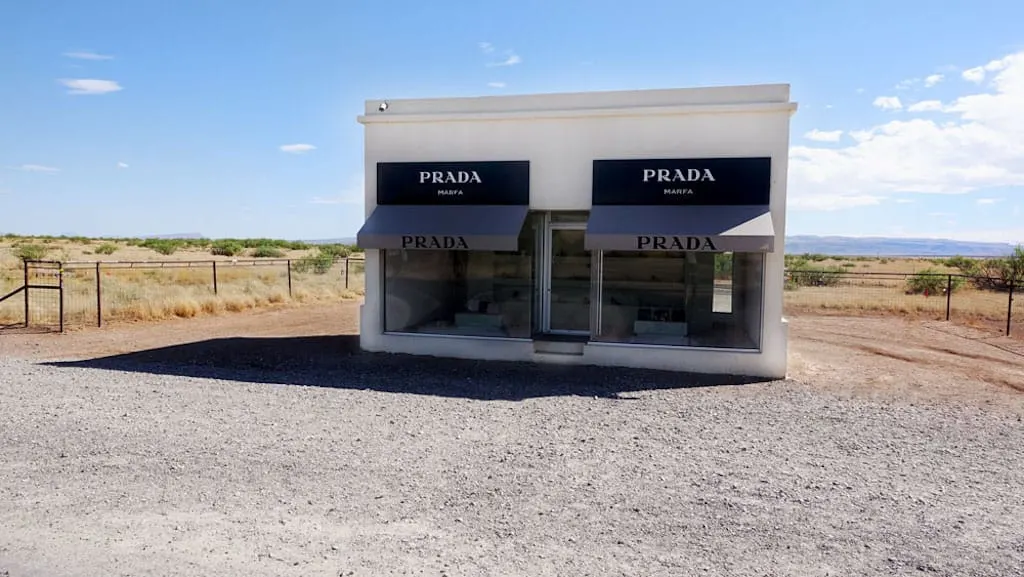
San Antonio River Walk
The most visited attraction in all of Texas, the San Antonio River Walk is a unique city park and network of walkways along the banks of the San Antonio River. Located one story beneath the streets of San Antonio, the River Walk is a crucial part of the city’s urban foundation and a tourist magnet that you could almost miss if you were just driving through at street level.
Conceived as a flood protection method in the 1920s, the River Walk winds and loops under the various bridges of central San Antonio and has two parallel sidewalks lined with delicious restaurants, tourist shops, hotels, and more. You can spend hours exploring its various areas, either on foot or by boat, and remain blissfully free of the barrage of automotive traffic that so often plagues U.S. city centers.
A magical place to relax, reconnect, and enjoy, the San Antonio River Walk is a unique landmark of Texas, and somewhere you can explore time and time again.
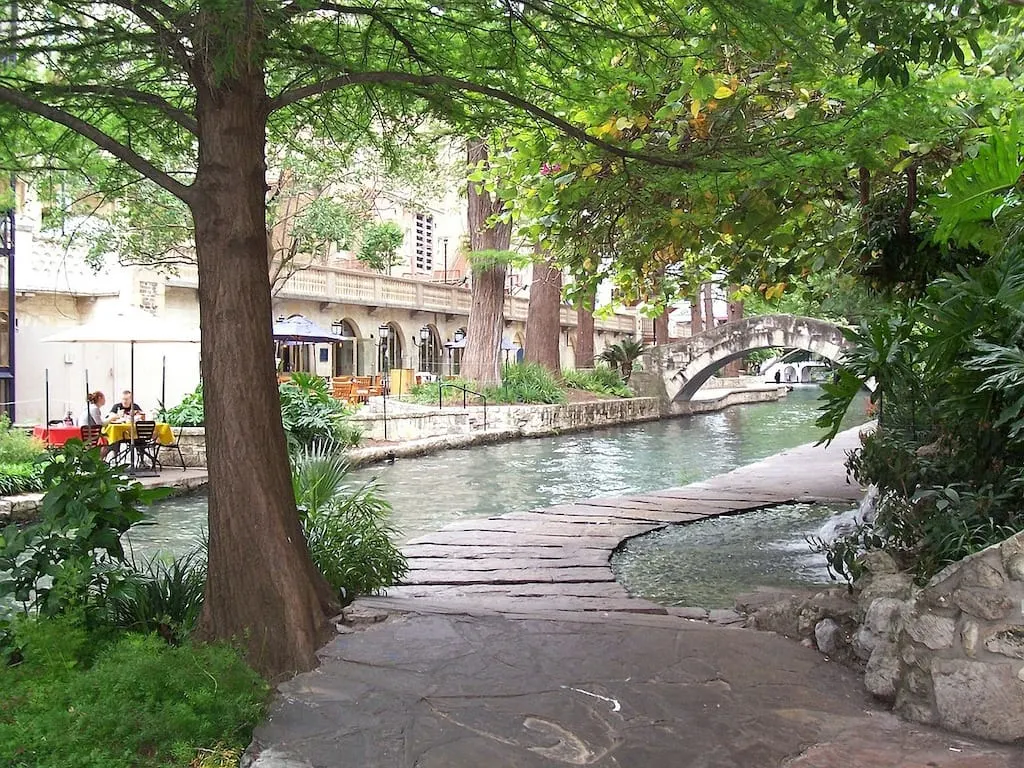
Selena Museum
When people think of Texan musicians and artists, three names immediately come to mind. Beyoncé. Meg thee Stallion. And of course – Selena. Although no last name is needed when referring to the Queen of Tejano music herself, Selena Quintanilla is a global icon that forever changed the music industry.
The state declared April 16th an official holiday recognizing the artist. Three years after her tragic murder, Selena’s family opened the Selena Museum in her hometown of Corpus Christi, built in the back of her recording studio, so that fans could honor her legacy. The museum is only open Monday through Friday, 10 am-4 pm, with a $3.00 USD admission fee. The museum offers plenty of free parking on-site, and photos are welcome as long as there is no flash.
Budget about an hour for your visit, so you can spend time browsing the dozens of awards, outfits, and memorabilia from the late singer. While you are in Corpus Christi, you can visit Selena’s grave at Seaside Memorial Park, adorned with billowing purple bouquets. There is also a life-sized Selena memorial at the pier, aptly named Mirador del la Flor, or Overlook of the Flower.
Neighboring cities such as San Antonio, one of the most culturally rich destinations in the U.S., has an entire festival dedicated to Selena and Tejano music. Selena’s legacy lives on through The Selena Museum, but also through the history of Texas.
Explored by Kay from The Awkward Traveller

Six Flags Over Texas
The original park in the now famous Six Flags chain, Six Flags Over Texas is Dallas-Fort Worth’s largest and most exciting theme park filled with over 45 thrilling rides, shows, & attractions. Located on 212-acres (86 ha), the original park was opened in 1961 by a wealthy real estate developer.
The name “Six Flags Over Texas” refers to the flags of the six different nations that have governed Texas: Spain, France, Mexico, the Republic of Texas, the United States of America, and the Confederate States of America. For each of the six governing bodies that controlled Texas, there is a different theme area in the park. The original six can still be located in the park; however, different zones have been created.
Not only is this a great day out and one of the most famous spots in Texas, but Six Flags Over Texas boasts many historic first including the first park to introduce a pay one price admission, the first to feature Broadway-style shows, the first log fume, and free-fall rides. If you can time your visit properly, there is a Fright Fest event in October that is similar (but not as good as) Halloween Horror Nights in Orlando or Holiday in the Park around Christmas.
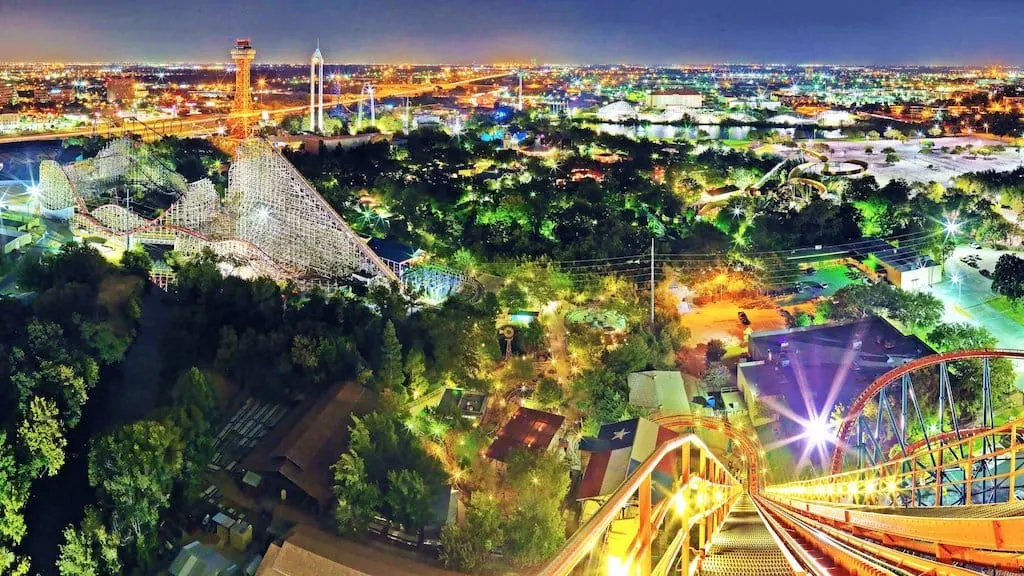
Texas Capitol Building
If you are visiting Austin, you can’t miss The Texas State Capitol. The capitol grounds are located in downtown Austin just south of the University of Texas at Austin area. The building itself is modeled after the design of the U.S. Capitol Building, but it is actually taller. One major difference is the exterior is local red granite.
When arriving at the Texas State Capitol, you can park for free at the visitor parking garage located just east of the grounds. From there, walk through any of the entrances where there are security checkpoints to go through. While anyone can wander the halls on their own, there are regular free tours that will take you through the capital, ensuring you won’t miss and of the important history or interesting facts about the building.
Inside there is an open rotunda under the dome with two wings that extend east and west. The rotunda is lined with paintings of the current and former governors, including a few former presidents and presidential hopefuls. The rotunda has quite a different look and feel from the fourth floor, where you can look down below. In addition, you can visit the Supreme Court Room, House of Representative Chambers, Senate Chambers, and many other rooms. Many of the rooms have unique artwork, historical pieces, or symbolic details like the brass chandeliers that spell out TEXAS in the lightbulbs, paintings that depict Texas’s history, and the flag from the 1836 Battle of San Jacinto.
Outside there are several acres of beautiful grounds with several statues and monuments remembering those that fought in the Alamo, volunteer firemen, Confederate Soldiers, Vietnam veterans, and others.
Explored by Dan from CabinCritic.co
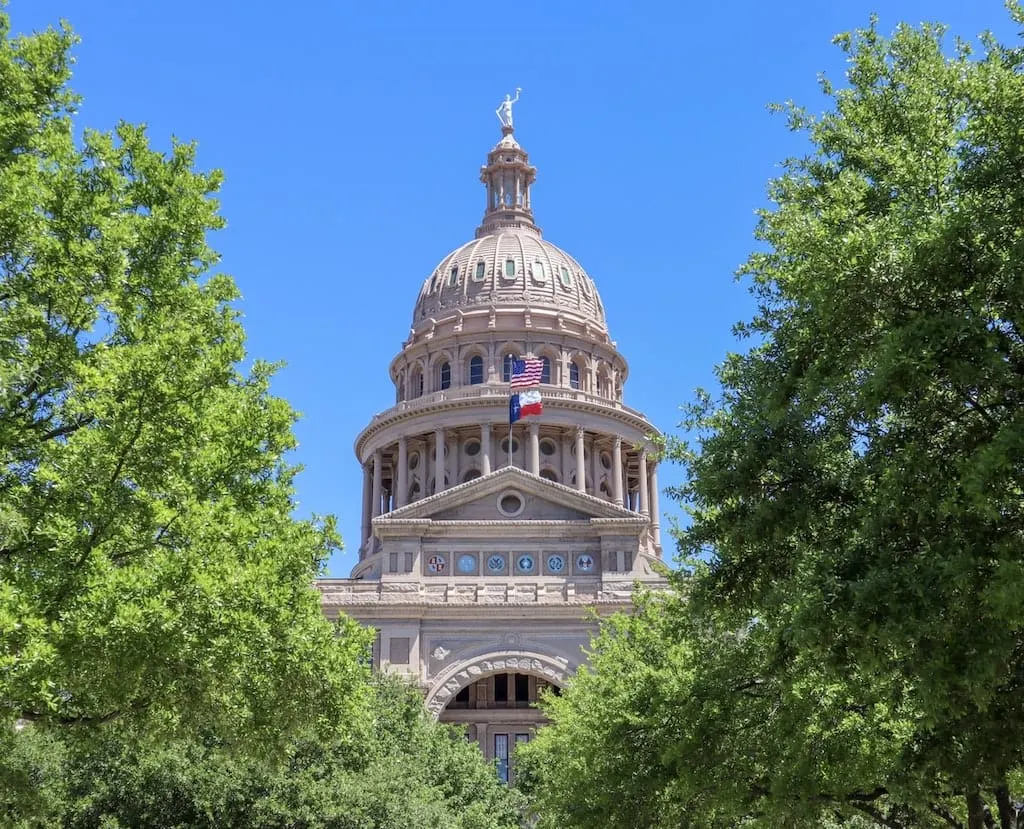
The Alamo
Mission San Antonio de Valero is one of Texas’s most famous landmarks, but today it is more commonly known as The Alamo. This famous Spanish mission complex was the first of eventual six San Antonio missions, which would be founded by Catholic missionaries at various points along the San Antonio River in the early 1700s.
The Missions were a community and learning hub for the Christianization of the local indigenous people, and a means to integrate them into Spanish life (Texas being part of the Spanish colony at the time). At the beginning of the 18th century, after the Mission was secularized, Spanish soldiers used the mission church as a fortress during the Mexican struggle for independence from Spain.
Later, during the Texas Revolution, the Alamo was where a small garrison of Texan soldiers died defending against the Mexican Army. As a result of this stand, the Alamo is not only one of Texas’s most famous buildings, but a national historic landmark. Conveniently located in downtown San Antonio, the Alamo is open to the public year-round.
There is a landscaped mission complex with various exhibits on Texas history, along with historical tours and talks.
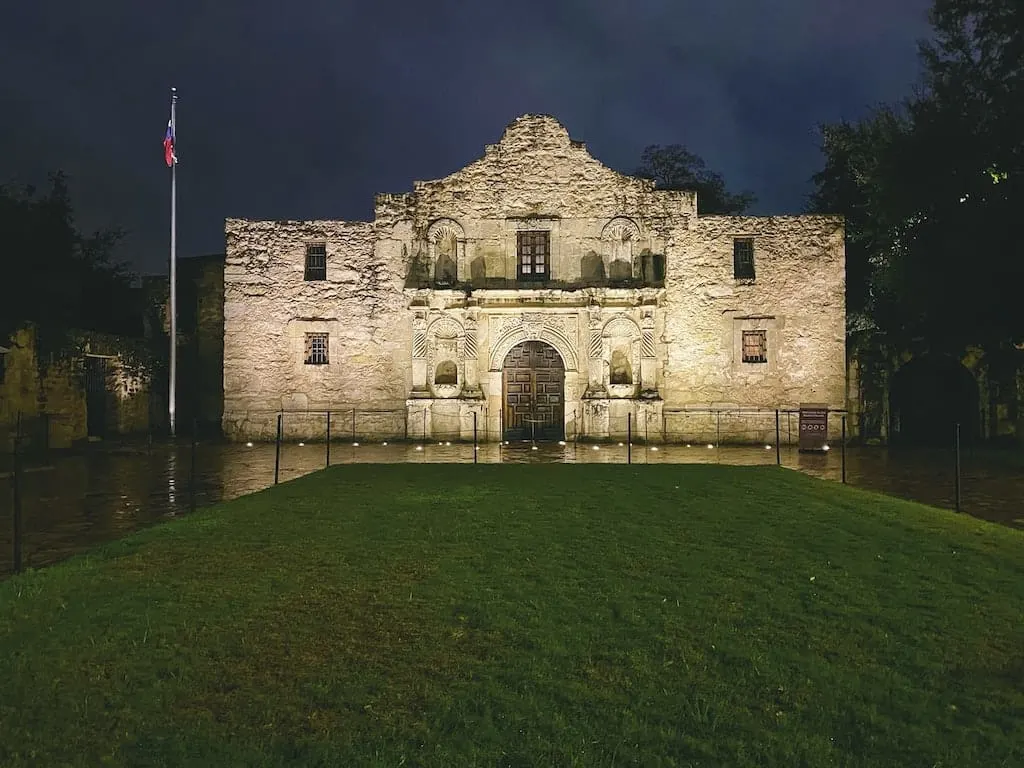
The Sixth Floor Museum at Dealey Plaza
One of the most famous landmarks in Texas is the former Texas School Book Depository, now known as the 6th Floor Museum. This incredible museum, found in the equally well-known Dealey Plaza in downtown Dallas, is located in the building from which Lee Harvey Oswald assassinated President John F. Kennedy on November 22, 1963, during his presidential motorcade through the city.
The building reopened as a museum on Presidents’ Day in 1989 and respectfully chronicled the life, work, and assassination of John F. Kennedy. You can watch historical film footage and hear testimony from first-hand sources. You’ll see priceless artifacts and learn more about assassination conspiracy theories than you can handle. Information is regularly updated as is needed, and as new discoveries are made.
The museum offers self-guided tours through the use of quality audio guides, and admission to the 6th Floor Museum is included in the Dallas CityPASS. The museum also showcases special exhibits and public programs, as well as includes a well put together gift shop. The 6th Floor Museum is a must when visiting, even if you only spend one day in Dallas.
Outside the museum, you’ll see two “X” on the street marking the two spots where J.F.K. was shot. And further down the street, you’ll find informational placards near the infamous “grassy knoll.” Across the street from the museum is Dealey Plaza–a nice park with fountains and memorials that’s on the National Register of Historic Places.
The 6th Floor Museum and Dealey Plaza have (paid) parking on site and are both accessible via public transportation.
Explored by Ashley Smith from My Wanderlusty Life
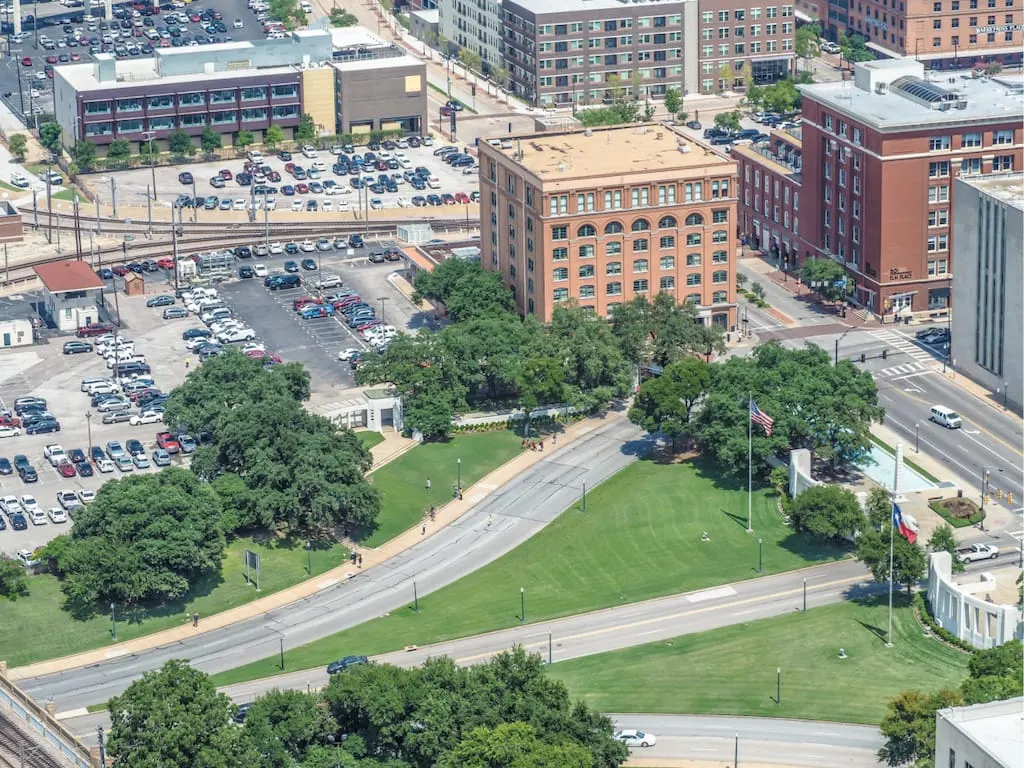
Tower of the Americas
San Antonio’s iconic Tower of the Americas is a 750-foot observation tower located in HemisFair Park. Originally erected in 1968 as the main structure for the World’s Fair, The Tower of the Americas was the tallest observation tower until 1996 when the Stratosphere Tower in Las Vegas was completed. It is currently the tallest building in San Antonio.
The Tower of the Americas has an observation tower that is accessible by elevator. Locals and tourists can pay a nominal fee to scale the tower and visit the observation deck. From the top, take in views of San Antonio’s most famous landmarks, including The Alamo, the San Antonio Missions, and others. Visitors can also learn about the history of the Six Flags over Texas and crucial Texas history.
Guests can also dine or enjoy a cocktail at one of the three dining options at the top. Chart House, a rotating restaurant, offers upscale dining with 360-degree views of San Antonio. Dining at Chart House, while pricy, allows guests to access the Observation Deck without paying the fee. Tower Café is a casual option both at the base of the tower and at the pinnacle, while Bar 601 provides cocktails and birds’ eye views of San Antonio.
HemisFair Park, where the Tower sits (and the home of the 1968 World’s Fair), is filled with cultural centers and buildings, fountains, and walking paths. Visitors heading to San Antonio with kids won’t want to miss Yanaguana Garden at HemisFair Park, as well.
Explored by Tori from Tori Leigh
